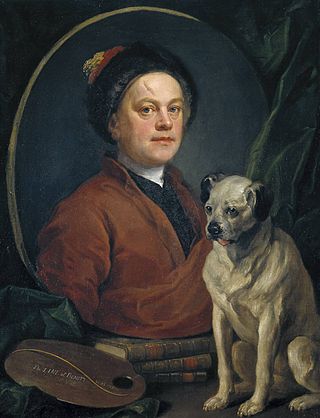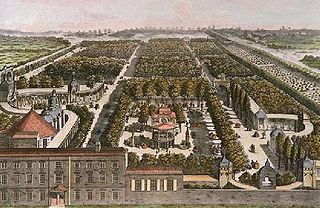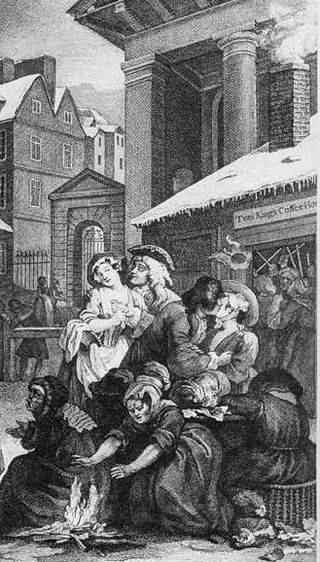
Samuel Butler was an English poet and satirist. He is remembered now chiefly for a long satirical poem titled Hudibras.

Samuel Pepys was an English diarist and naval administrator. He served as administrator of the Royal Navy and Member of Parliament, but is most remembered today for the diary he kept for almost a decade. Though he had no maritime experience, Pepys rose to be the Chief Secretary to the Admiralty under both King Charles II and King James II through patronage, diligence, and his talent for administration. His influence and reforms at the Admiralty were important in the early professionalisation of the Royal Navy.

William Hogarth was an English painter, engraver, pictorial satirist, social critic, editorial cartoonist and occasional writer on art. His work ranges from realistic portraiture to comic strip-like series of pictures called "modern moral subjects", and he is perhaps best known for his series A Harlot's Progress, A Rake's Progress and Marriage A-la-Mode. Knowledge of his work is so pervasive that satirical political illustrations in this style are often referred to as "Hogarthian".

A rushlight is a type of candle or miniature torch formed by soaking the dried pith of the rush plant in fat or grease. For several centuries, rushlights were a common source of artificial light for poor people throughout the British Isles. They were extremely inexpensive to make. English essayist William Cobbett wrote, "This rushlight cost almost nothing to produce and was believed to give a better light than some poorly dipped candles."

Vauxhall Gardens is a public park in Kennington in the London Borough of Lambeth, England, on the south bank of the River Thames.
A Rake's Progress is a series of eight paintings by 18th-century English artist William Hogarth. The canvases were produced in 1732–1734, then engraved in 1734 and published in print form in 1735. The series shows the decline and fall of Tom Rakewell, the spendthrift son and heir of a rich merchant, who comes to London, wastes all his money on luxurious living, prostitution and gambling, and as a consequence is imprisoned in the Fleet Prison and ultimately Bethlem Hospital (Bedlam). The original paintings are in the collection of Sir John Soane's Museum in London, where they are normally on display for a short period each day.

The litter is a class of wheelless vehicles, a type of human-powered transport, for the transport of people. Smaller litters may take the form of open chairs or beds carried by two or more carriers, some being enclosed for protection from the elements. Larger litters, for example those of the Chinese emperors, may resemble small rooms upon a platform borne upon the shoulders of a dozen or more people. To most efficiently carry a litter, porters either place the carrying poles directly upon their shoulders or use a yoke to transfer the load from the carrying poles to the shoulders.
Light as a feather, stiff as a board is a game played by children at slumber parties. The phrase has also become established in popular culture as a reference to a levitation trick, and has been referred to in various media accounts. In performing magic this effect is known as abnormal lift.

The Tête à Tête is the second canvas in the series of six satirical paintings known as Marriage A-la-Mode, painted by William Hogarth.

The Four Stages of Cruelty is a series of four printed engravings published by English artist William Hogarth in 1751. Each print depicts a different stage in the life of the fictional Tom Nero.

Four Times of the Day is a series of four oil paintings by English artist William Hogarth. They were completed in 1736 and in 1738 were reproduced and published as a series of four engravings. They are humorous depictions of life in the streets of London, the vagaries of fashion, and the interactions between the rich and poor. Unlike many of Hogarth's other series, such as A Harlot's Progress, A Rake's Progress, Industry and Idleness, and The Four Stages of Cruelty, it does not depict the story of an individual, but instead focuses on the society of the city in a humorous manner. Hogarth does not offer a judgment on whether the rich or poor are more deserving of the viewer's sympathies. In each scene, while the upper and middle classes tend to provide the focus, there are fewer moral comparisons than seen in some of his other works. Their dimensions are about 74 cm (29 in) by 61 cm (24 in) each.

Strolling Actresses Dressing in a Barn is a painting from 1738 by British artist William Hogarth. It was reproduced as an engraving and issued with Four Times of the Day as a five print set in the same year.

Tom King's Coffee House was a notorious establishment in Covent Garden, London in the mid-18th century. Open from the time the taverns shut until dawn, it was ostensibly a coffee house, but in reality served as a meeting place for prostitutes and their customers. By refusing to provide beds, the Kings ensured that they never risked charges of brothel-keeping, but the venue was nevertheless a rowdy drinking den and a favourite target for the moral reformers of the day.

A candle auction, or auction by the candle, is a variation on the typical English auction that became popular in the 17th and 18th centuries. In a candle auction, the end of the auction is signaled by the expiration of a candle flame, which was intended to ensure that no one could know exactly when the auction would end and make a last-second bid. Sometimes, other unpredictable processes, such as a footrace, were used in place of the expiration of a candle.

Beer Street and Gin Lane are two prints issued in 1751 by English artist William Hogarth in support of what would become the Gin Act. Designed to be viewed alongside each other, they depict the evils of the consumption of gin as a contrast to the merits of drinking beer. At almost the same time and on the same subject, Hogarth's friend Henry Fielding published An Inquiry into the Late Increase in Robbers. Issued together with The Four Stages of Cruelty, the prints continued a movement started in Industry and Idleness, away from depicting the laughable foibles of fashionable society and towards a more cutting satire on the problems of poverty and crime.

Elizabeth Needham, also known as Mother Needham, was an English procuress and brothel-keeper of 18th-century London, who has been identified as the bawd greeting Moll Hackabout in the first plate of William Hogarth's series of satirical etchings, A Harlot's Progress. Although Needham was notorious in London at the time, little is recorded of her life, and no genuine portraits of her survive. Her house was the most exclusive in London and her customers came from the highest strata of fashionable society, but she eventually ran afoul of the moral reformers of the day and died as a result of the severe treatment she received after being sentenced to stand in the pillory.

Betty Careless or Betsy Careless was a notorious prostitute and later bagnio-owner in 18th-century London. Probably born Elizabeth Carless, she adapted her name to better suit her profession. Her name, beauty and reputation made her, like Sally Salisbury before her, something of an archetypal courtesan for the popular culture of the day.

Emily Pepys was an English child diarist, whose account of six months of her life provides a vivid insight into a wealthy bishop's family. She was a collateral descendant of the diarist Samuel Pepys.

The Two Chairmen is thought to be the oldest public house in Westminster. Its pub sign, featuring two men carrying a sedan chair, can be traced back to 1729. The pub is near Birdcage Walk, where James I had aviaries for exotic birds, and close to St James's Park tube station. It has been called 'The hidden gem of Dartmouth Street' by The London Evening Standard. It is a Grade II listed building.



















